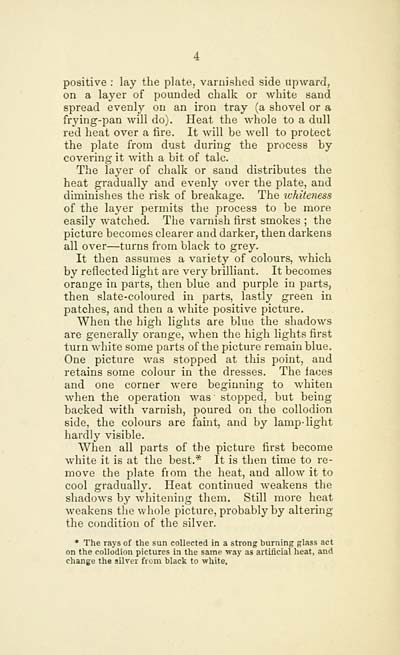Download files
Complete book:
Individual page:
Thumbnail gallery: Grid view | List view

positive : lay the plate, varnished side upward,
on a layer of pounded chalk or white sand
spread evenly on an iron tray (a shovel or a
frying-pan will do). Heat the whole to a dull
red heat over a fire. It will be well to protect
the plate from dust during the process by
covering it with a bit of talc.
The layer of chalk or sand distributes the
heat gradually and evenly over the plate, and
diminishes the risk of breakage. The ivhiteness
of the layer permits the process to be more
easily watched. The varnish first smokes ; the
picture becomes clearer and darker, then darkens
all over — turns from black to grey.
It then assumes a variety of colours, which
by reflected light are very brilliant. It becomes
orange in parts, then blue and purple in parts,
then slate-coloured in parts, lastly green in
patches, and then a white positive picture.
When the high lights are blue the shadows
are generally orange, when the high lights first
turn white some parts of the picture remain blue.
One picture was stopped at this point, and
retains some colour in the dresses. The faces
and one corner were beginning to w^hiten
when the operation was stopped, but being
backed with varnish, poured on the collodion
side, the colours are faint, and by lamp- light
hardly visible.
When all parts of the picture first become
white it is at the best.* It is then time to re-
move the plate from the heat, and allow it to
cool graduall3^ Heat continued weakens the
shadows by whitening them. Still more heat
weakens the whole picture, probably by altering
the condition of the silver.
* The rays of the sun collected in a strong burning glass act
on the collodion pictures in the same way as artificial heat, and
change the silver from black to white.
on a layer of pounded chalk or white sand
spread evenly on an iron tray (a shovel or a
frying-pan will do). Heat the whole to a dull
red heat over a fire. It will be well to protect
the plate from dust during the process by
covering it with a bit of talc.
The layer of chalk or sand distributes the
heat gradually and evenly over the plate, and
diminishes the risk of breakage. The ivhiteness
of the layer permits the process to be more
easily watched. The varnish first smokes ; the
picture becomes clearer and darker, then darkens
all over — turns from black to grey.
It then assumes a variety of colours, which
by reflected light are very brilliant. It becomes
orange in parts, then blue and purple in parts,
then slate-coloured in parts, lastly green in
patches, and then a white positive picture.
When the high lights are blue the shadows
are generally orange, when the high lights first
turn white some parts of the picture remain blue.
One picture was stopped at this point, and
retains some colour in the dresses. The faces
and one corner were beginning to w^hiten
when the operation was stopped, but being
backed with varnish, poured on the collodion
side, the colours are faint, and by lamp- light
hardly visible.
When all parts of the picture first become
white it is at the best.* It is then time to re-
move the plate from the heat, and allow it to
cool graduall3^ Heat continued weakens the
shadows by whitening them. Still more heat
weakens the whole picture, probably by altering
the condition of the silver.
* The rays of the sun collected in a strong burning glass act
on the collodion pictures in the same way as artificial heat, and
change the silver from black to white.
Set display mode to: Large image | Transcription
Images and transcriptions on this page, including medium image downloads, may be used under the Creative Commons Attribution 4.0 International Licence unless otherwise stated. ![]()
| Early Gaelic Book Collections > J. F. Campbell Collection > Method of converting collodion negatives into positives, by heat > (4) |
|---|
| Permanent URL | https://digital.nls.uk/80584482 |
|---|
| Description | Volumes from a collection of 610 books rich in Highland folklore, Ossianic literature and other Celtic subjects. Many of the books annotated by John Francis Campbell of Islay, who assembled the collection. |
|---|
| Description | Selected items from five 'Special and Named Printed Collections'. Includes books in Gaelic and other Celtic languages, works about the Gaels, their languages, literature, culture and history. |
|---|

